Freshwater Salinization Syndrome Alters Nitrogen Transport in Urban Watersheds
Abstract
:1. Introduction
2. Methods
2.1. Study Sites
2.2. Field Measurements
Routine Monitoring and High-Frequency Monitoring
2.3. Laboratory
2.3.1. Water Quality Analyses
2.3.2. Numerical Analysis and Plotting
3. Results
3.1. Seasonal Trends in Routine Sampling Sites and USGS Data
3.2. Targeted Storm Event Sampling of Winter Precipitation (Sligo Creek)
3.3. Hysteresis of Nitrogen Concentrations during Winter Snow Events
3.4. Plateaus in N Concentrations over Time during Road Salt Events
4. Discussion
4.1. FSS and Mobilization of TDN and NO3−/NO2− Pulses
4.2. Concurrent N Build and Flush in Temperate Watersheds
4.3. High Temporal Frequency Sampling and Storm Hysteresis
4.4. Plateaus in N Concentrations over Time during Road Salt Events
4.5. Nitrate and Chloride Fluxes across Land Use
5. Conclusions
Supplementary Materials
Author Contributions
Funding
Data Availability Statement
Acknowledgments
Conflicts of Interest
References
- Kaushal, S.S.; Groffman, P.M.; Likens, G.E.; Belt, K.T.; Stack, W.P.; Kelly, V.R.; Band, L.E.; Fisher, G.T. Increased Salinization of Fresh Water in the Northeastern United States. Proc. Natl. Acad. Sci. USA 2005, 102, 13517–13520. [Google Scholar] [CrossRef] [PubMed]
- Kaushal, S.S.; Gold, A.J.; Bernal, S.; Johnson, T.A.N.; Addy, K.; Burgin, A.; Burns, D.A.; Coble, A.A.; Hood, E.; Lu, Y.; et al. Watershed ‘Chemical Cocktails’: Forming Novel Elemental Combinations in Anthropocene Fresh Waters. Biogeochemistry 2018, 141, 281–305. [Google Scholar] [CrossRef] [PubMed]
- Kaushal, S.S.; Likens, G.E.; Pace, M.L.; Haq, S.; Wood, K.L.; Galella, J.G.; Morel, C.; Doody, T.R.; Wessel, B.; Kortelainen, P.; et al. Novel ‘chemical Cocktails’ in Inland Waters Are a Consequence of the Freshwater Salinization Syndrome. Philos. Trans. R. Soc. B Biol. Sci. 2019, 374, 20180017. [Google Scholar] [CrossRef] [PubMed]
- Galella, J.G.; Kaushal, S.S.; Wood, K.L.; Reimer, J.E.; Mayer, P.M. Sensors Track Mobilization of ‘chemical Cocktails’ in Streams Impacted by Road Salts in the Chesapeake Bay Watershed. Environ. Res. Lett. 2021, 16, 035017. [Google Scholar] [CrossRef] [PubMed]
- Jackson, R.; Jobbágy, E. From Icy Roads to Salty Streams. Proc. Natl. Acad. Sci. USA 2005, 102, 14487–14488. [Google Scholar] [CrossRef] [PubMed]
- Pecher, W.T.; Madadha, M.E.A.; DasSarma, P.; Ekulona, F.; Schott, E.J.; Crowe, K.; Gut, B.S.; DasSarma, S. Effects of Road Salt on Microbial Communities: Halophiles as Biomarkers of Road Salt Pollution. PLoS ONE 2019, 14, e0221355. [Google Scholar] [CrossRef]
- Vogler, J.B.; Vukomanovic, J. Trends in United States Human Footprint Revealed by New Spatial Metrics of Urbanization and Per Capita Land Change. Sustainability 2021, 13, 12852. [Google Scholar] [CrossRef]
- Corsi, S.R.; Graczyk, D.J.; Geis, S.W.; Booth, N.L.; Richards, K.D. A Fresh Look at Road Salt: Aquatic Toxicity and Water-Quality Impacts on Local, Regional, and National Scales. Environ. Sci. Technol. 2010, 44, 7376–7382. [Google Scholar] [CrossRef]
- Haq, S.; Kaushal, S.S.; Duan, S. Episodic Salinization and Freshwater Salinization Syndrome Mobilize Base Cations, Carbon, and Nutrients to Streams across Urban Regions. Biogeochemistry 2018, 141, 463–486. [Google Scholar] [CrossRef]
- Hintz, W.D.; Fay, L.; Relyea, R.A. Road Salts, Human Safety, and the Rising Salinity of Our Fresh Waters. Front. Ecol. Environ. 2022, 20, 22–30. [Google Scholar] [CrossRef]
- Hintz, W.D.; Relyea, R.A. A Review of the Species, Community, and Ecosystem Impacts of Road Salt Salinisation in Fresh Waters. Freshw. Biol. 2019, 64, 1081–1097. [Google Scholar] [CrossRef]
- Duan, S.; Kaushal, S.S. Salinization Alters Fluxes of Bioreactive Elements from Stream Ecosystems across Land Use. Biogeosciences 2015, 12, 7331–7347. [Google Scholar] [CrossRef]
- Galella, J.G.; Kaushal, S.S.; Mayer, P.M.; Maas, C.M.; Shatkay, R.R.; Stutzke, R.A. Stormwater Best Management Practices: Experimental Evaluation of Chemical Cocktails Mobilized by Freshwater Salinization Syndrome. Front. Environ. Sci. 2023, 11, 339. [Google Scholar] [CrossRef] [PubMed]
- Howarth, R.W.; Marino, R. Nitrogen as the Limiting Nutrient for Eutrophication in Coastal Marine Ecosystems: Evolving Views over Three Decades. Limnol. Oceanogr. 2006, 51, 364–376. [Google Scholar] [CrossRef]
- Kaushal, S.S.; Groffman, P.M.; Band, L.E.; Shields, C.A.; Morgan, R.P.; Palmer, M.A.; Belt, K.T.; Swan, C.M.; Findlay, S.E.G.; Fisher, G.T. Interaction between Urbanization and Climate Variability Amplifies Watershed Nitrate Export in Maryland. Environ. Sci. Technol. 2008, 42, 5872–5878. [Google Scholar] [CrossRef]
- Testa, J.M.; Kemp, W.M.; Boynton, W.R. Season-Specific Trends and Linkages of Nitrogen and Oxygen Cycles in Chesapeake Bay. Limnol. Oceanogr. 2018, 63, 2045–2064. [Google Scholar] [CrossRef]
- Wurtsbaugh, W.A.; Paerl, H.W.; Dodds, W.K. Nutrients, Eutrophication and Harmful Algal Blooms along the Freshwater to Marine Continuum. WIREs Water 2019, 6, e1373. [Google Scholar] [CrossRef]
- Inamdar, S.P.; Peck, E.K.; Peipoch, M.; Gold, A.J.; Sherman, M.; Hripto, J.; Groffman, P.M.; Trammell, T.L.E.; Merritts, D.J.; Addy, K.; et al. Saturated, Suffocated, and Salty: Human Legacies Produce Hot Spots of Nitrogen in Riparian Zones. J. Geophys. Res. Biogeosci. 2022, 127, e2022JG007138. [Google Scholar] [CrossRef]
- McHale, M.R.; McDonnell, J.J.; Mitchell, M.J.; Cirmo, C.P. A Field-Based Study of Soil Water and Groundwater Nitrate Release in an Adirondack Forested Watershed. Water Resour. Res. 2002, 38, 2-1–2-16. [Google Scholar] [CrossRef]
- Brooks, P.D.; Schmidt, S.K.; Williams, M.W. Winter Production of CO2 and N2O from Alpine Tundra: Environmental Controls and Relationship to Inter-System C and N Fluxes. Oecologia 1997, 110, 403–413. [Google Scholar] [CrossRef]
- Brooks, P.D.; Williams, M.W.; Schmidt, S.K. Inorganic Nitrogen and Microbial Biomass Dynamics before and during Spring Snowmelt. Biogeochemistry 1998, 43, 1–15. [Google Scholar] [CrossRef]
- Burns, D.A.; Murdoch, P.S.; Lawrence, G.B.; Michel, R.L. Effect of Groundwater Springs on NO3− Concentrations during Summer in Catskill Mountain Streams. Water Resour. Res. 1998, 34, 1987–1996. [Google Scholar] [CrossRef]
- Groffman, P.M.; Law, N.L.; Belt, K.T.; Band, L.E.; Fisher, G.T. Nitrogen Fluxes and Retention in Urban Watershed Ecosystems. Ecosystems 2004, 7, 393–403. [Google Scholar] [CrossRef]
- Mulholland, P.J. The Importance of In-Stream Uptake for Regulating Stream Concentrations and Outputs of N and P from a Forested Watershed: Evidence from Long-Term Chemistry Records for Walker Branch Watershed. Biogeochemistry 2004, 70, 403–426. [Google Scholar] [CrossRef]
- Swank, W.T.; Vose, J.M. Long-Term Nitrogen Dynamics of Coweeta Forested Watersheds in the Southeastern United States of America. Glob. Biogeochem. Cycles 1997, 11, 657–671. [Google Scholar] [CrossRef]
- Kaushal, S.S.; Mayer, P.M.; Vidon, P.G.; Smith, R.M.; Pennino, M.J.; Newcomer, T.A.; Duan, S.; Welty, C.; Belt, K.T. Land Use and Climate Variability Amplify Carbon, Nutrient, and Contaminant Pulses: A Review with Management Implications. JAWRA J. Am. Water Resour. Assoc. 2014, 50, 585–614. [Google Scholar] [CrossRef]
- Hale, R.L.; Groffman, P.M. Chloride Effects on Nitrogen Dynamics in Forested and Suburban Stream Debris Dams. J. Environ. Qual. 2006, 35, 2425–2432. [Google Scholar] [CrossRef]
- Kaushal, S.S.; Groffman, P.M.; Band, L.E.; Elliott, E.M.; Shields, C.A.; Kendall, C. Tracking Nonpoint Source Nitrogen Pollution in Human-Impacted Watersheds. Environ. Sci. Technol. 2011, 45, 8225–8232. [Google Scholar] [CrossRef]
- Groffman, P.M.; Bain, D.J.; Band, L.E.; Belt, K.T.; Brush, G.S.; Grove, J.M.; Pouyat, R.V.; Yesilonis, I.C.; Zipperer, W.C. Down by the Riverside: Urban Riparian Ecology. Front. Ecol. Environ. 2003, 1, 315–321. [Google Scholar] [CrossRef]
- Mayer, P.M.; Groffman, P.M.; Striz, E.A.; Kaushal, S.S. Nitrogen Dynamics at the Groundwater–Surface Water Interface of a Degraded Urban Stream. J. Environ. Qual. 2010, 39, 810–823. [Google Scholar] [CrossRef]
- Pennino, M.J.; Kaushal, S.S.; Murthy, S.N.; Blomquist, J.D.; Cornwell, J.C.; Harris, L.A. Sources and Transformations of Anthropogenic Nitrogen along an Urban River–Estuarine Continuum. Biogeosciences 2016, 13, 6211–6228. [Google Scholar] [CrossRef]
- Alberts, J.M.; Beaulieu, J.J.; Buffam, I. Watershed Land Use and Seasonal Variation Constrain the Influence of Riparian Canopy Cover on Stream Ecosystem Metabolism. Ecosystems 2017, 20, 553–567. [Google Scholar] [CrossRef]
- Elmore, A.J.; Kaushal, S.S. Disappearing Headwaters: Patterns of Stream Burial Due to Urbanization. Front. Ecol. Environ. 2008, 6, 308–312. [Google Scholar] [CrossRef] [PubMed]
- Pennino, M.J.; Kaushal, S.S.; Beaulieu, J.J.; Mayer, P.M.; Arango, C.P. Effects of Urban Stream Burial on Nitrogen Uptake and Ecosystem Metabolism: Implications for Watershed Nitrogen and Carbon Fluxes. Biogeochemistry 2014, 121, 247–269. [Google Scholar] [CrossRef]
- Wollheim, W.M.; Bernal, S.; Burns, D.A.; Czuba, J.A.; Driscoll, C.T.; Hansen, A.T.; Hensley, R.T.; Hosen, J.D.; Inamdar, S.; Kaushal, S.S.; et al. River Network Saturation Concept: Factors Influencing the Balance of Biogeochemical Supply and Demand of River Networks. Biogeochemistry 2018, 141, 503–521. [Google Scholar] [CrossRef]
- Kaushal, S.; Wood, K.L.; Galella, J.G.; Reimer, J.; Haq, S.; Gion, A.M.; Haviland, K.; Morel, C.; Wessel, B.; Nguyen, W.D.; et al. Making ‘Chemical Cocktails’ in Streams across the Periodic Table of Elements. Appl. Geochem. 2020, 2020, H092-08. [Google Scholar]
- Kaushal, S.S.; Likens, G.E.; Pace, M.L.; Reimer, J.E.; Maas, C.M.; Galella, J.G.; Utz, R.M.; Duan, S.; Kryger, J.R.; Yaculak, A.M.; et al. Freshwater Salinization Syndrome: From Emerging Global Problem to Managing Risks. Biogeochemistry 2021, 154, 255–292. [Google Scholar] [CrossRef]
- Kaushal, S.S.; Reimer, J.E.; Mayer, P.M.; Shatkay, R.R.; Maas, C.M.; Nguyen, W.D.; Boger, W.L.; Yaculak, A.M.; Doody, T.R.; Pennino, M.J.; et al. Freshwater Salinization Syndrome Alters Retention and Release of Chemical Cocktails along Flowpaths: From Stormwater Management to Urban Streams. Freshw. Sci. 2022, 41, 420–441. [Google Scholar] [CrossRef]
- Ardón, M.; Morse, J.L.; Colman, B.P.; Bernhardt, E.S. Drought-Induced Saltwater Incursion Leads to Increased Wetland Nitrogen Export. Glob. Chang. Biol. 2013, 19, 2976–2985. [Google Scholar] [CrossRef]
- Kinsman-Costello, L.; Bean, E.; Goeckner, A.; Matthews, J.W.; O’Driscoll, M.; Palta, M.M.; Peralta, A.L.; Reisinger, A.J.; Reyes, G.J.; Smyth, A.R.; et al. Mud in the City: Effects of Freshwater Salinization on Inland Urban Wetland Nitrogen and Phosphorus Availability and Export. Limnol. Oceanogr. Lett. 2022, 8, 112–130. [Google Scholar] [CrossRef]
- Rysgaard, S.; Thastum, P.; Dalsgaard, T.; Christensen, P.B.; Sloth, N.P. Effects of Salinity on NH4+ Adsorption Capacity, Nitrification, and Denitrification in Danish Estuarine Sediments. Estuaries 1999, 22, 21–30. [Google Scholar] [CrossRef]
- Seitzinger, S.P.; Gardner, W.S.; Spratt, A.K. The Effect of Salinity on Ammonium Sorption in Aquatic Sediments: Implications for Benthic Nutrient Recycling. Estuaries 1991, 14, 167–174. [Google Scholar] [CrossRef]
- Kachurina, O.; Zhang, H.; Raun, W.; Krenzer, E. Simultaneous Determination of Soil Aluminum, Ammonium- and Nitrate-nitrogen Using 1 M Potassium Chloride Extraction. Commun. Soil Sci. Plant Anal. 2000, 31, 893–903. [Google Scholar] [CrossRef]
- Shuman, L.M.; Duncan, R.R. Soil Exchangeable Cations and Aluminum Measured by Ammonium Chloride, Potassium Chloride, and Ammonium Acetate. Commun. Soil Sci. Plant Anal. 1990, 21, 1217–1228. [Google Scholar] [CrossRef]
- Herbert, E.R.; Boon, P.; Burgin, A.J.; Neubauer, S.C.; Franklin, R.B.; Ardón, M.; Hopfensperger, K.N.; Lamers, L.P.M.; Gell, P. A Global Perspective on Wetland Salinization: Ecological Consequences of a Growing Threat to Freshwater Wetlands. Ecosphere 2015, 6, art206. [Google Scholar] [CrossRef]
- Compton, J.E.; Church, M.R. Salt Additions Alter Short-Term Nitrogen and Carbon Mobilization in a Coastal Oregon Andisol. J. Environ. Qual. 2011, 40, 1601–1606. [Google Scholar] [CrossRef]
- Duckworth, C.M.S.; Cresser, M.S. Factors Influencing Nitrogen Retention in Forest Soils. Environ. Pollut. 1991, 72, 1–21. [Google Scholar] [CrossRef]
- Green, S.M.; Machin, R.; Cresser, M.S. Effect of Long-Term Changes in Soil Chemistry Induced by Road Salt Applications on N-Transformations in Roadside Soils. Environ. Pollut. 2008, 152, 20–31. [Google Scholar] [CrossRef]
- Kim, S.; Koretsky, C. Influence of NaCl and CaCl2 on Lake Sediment Biogeochemistry. Appl. Geochem. 2011, 26, S198–S201. [Google Scholar] [CrossRef]
- Nieder, R.; Benbi, D.K.; Scherer, H.W. Fixation and Defixation of Ammonium in Soils: A Review. Biol. Fertil. Soils 2011, 47, 1–14. [Google Scholar] [CrossRef]
- Steele, M.K.; Aitkenhead-Peterson, J.A. Salt Impacts on Organic Carbon and Nitrogen Leaching from Senesced Vegetation. Biogeochemistry 2013, 112, 245–259. [Google Scholar] [CrossRef]
- Lancaster, N.A.; Bushey, J.T.; Tobias, C.R.; Song, B.; Vadas, T.M. Impact of Chloride on Denitrification Potential in Roadside Wetlands. Environ. Pollut. 2016, 212, 216–223. [Google Scholar] [CrossRef] [PubMed]
- Inamdar, S.P.; Christopher, S.F.; Mitchell, M.J. Export Mechanisms for Dissolved Organic Carbon and Nitrate during Summer Storm Events in a Glaciated Forested Catchment in New York, USA. Hydrol. Process. 2004, 18, 2651–2661. [Google Scholar] [CrossRef]
- Poor, C.J.; McDonnell, J.J. The Effects of Land Use on Stream Nitrate Dynamics. J. Hydrol. 2007, 332, 54–68. [Google Scholar] [CrossRef]
- Creed, I.F.; Band, L.E.; Foster, N.W.; Morrison, I.K.; Nicolson, J.A.; Semkin, R.S.; Jeffries, D.S. Regulation of Nitrate-N Release from Temperate Forests: A Test of the N Flushing Hypothesis. Water Resour. Res. 1996, 32, 3337–3354. [Google Scholar] [CrossRef]
- Creed, I.F.; Band, L.E. Export of Nitrogen from Catchments within a Temperate Forest: Evidence for a Unifying Mechanism Regulated by Variable Source Area Dynamics. Water Resour. Res. 1998, 34, 3105–3120. [Google Scholar] [CrossRef]
- StreamStats. Available online: https://streamstats.usgs.gov/ss/ (accessed on 13 October 2022).
- MRLC. Available online: https://www.mrlc.gov/ (accessed on 13 October 2022).
- ISCO 3700. Available online: https://store.teledyneisco.com/pages/3700 (accessed on 28 March 2023).
- USGS NWIS USGS Water Data for the Nation. Available online: https://waterdata.usgs.gov/nwis (accessed on 13 October 2022).
- Gibs, J.; Wilde, F.D.; Heckathorn, H.A. Multiparameter Instruments; Version 1.1; Use of Multiparameter 6.8; USGS: Reston, VA, USA, 2012; 48p.
- Wagner, R.J.; Boulge, R.W., Jr.; Oblinger, C.J.; Smith, B.A. Guidelines and Standard Procedures for Continuous Water-Quality Monitors: Station Operation, Record Computation, and Data Reporting; Techniques and Methods; USGS: Reston, VA, USA, 2006; Volume 1-D3.
- USGS. Available online: https://www.usgs.gov/special-topics/water-science-school/science/how-streamflow-measured?qt-science_center_objects=0#qt-science_center_objects (accessed on 27 November 2022).
- TOC-L Series. Available online: https://www.ssi.shimadzu.com/products/total-organic-carbon-analysis/toc-analysis/toc-l-series/index.html (accessed on 28 March 2023).
- Capacasa, J.M. Rock Creek TMDL 2007. United States Environmental Protection Agency Region III 1650 Arch Street Philadelphia, Pennsylvania 19103-2029. Available online: https://mde.maryland.gov/programs/Water/TMDL/DocLib_RockCreek_02140206/RockCreek_FC_DR.pdf (accessed on 8 November 2023).
- Johnson, H.M.; Stets, E.G. Nitrate in Streams During Winter Low-Flow Conditions as an Indicator of Legacy Nitrate. Water Resour. Res. 2020, 56, e2019WR026996. [Google Scholar] [CrossRef]
- Kaushal, S.S.; Lewis, W.M. Fate and Transport of Organic Nitrogen in Minimally Disturbed Montane Streams of Colorado, USA. Biogeochemistry 2005, 74, 303–321. [Google Scholar] [CrossRef]
- Brookshire, J.E.N.; Gerber, S.; Webster, J.R.; Vose, J.M.; Swank, W.T. Direct Effects of Temperature on Forest Nitrogen Cycling Revealed through Analysis of Long-Term Watershed Records. Glob. Chang. Biol. 2011, 17, 297–308. [Google Scholar] [CrossRef]
- Eimers, M.C.; Buttle, J.M.; Watmough, S.A. The Contribution of Rain-on-Snow Events to Annual NO3-N Export from a Forested Catchment in South-Central Ontario, Canada. Appl. Geochem. 2007, 22, 1105–1110. [Google Scholar] [CrossRef]
- Vaughan, M.C.H.; Bowden, W.B.; Shanley, J.B.; Vermilyea, A.; Sleeper, R.; Gold, A.J.; Pradhanang, S.M.; Inamdar, S.P.; Levia, D.F.; Andres, A.S.; et al. High-Frequency Dissolved Organic Carbon and Nitrate Measurements Reveal Differences in Storm Hysteresis and Loading in Relation to Land Cover and Seasonality. Water Resour. Res. 2017, 53, 5345–5363. [Google Scholar] [CrossRef]
- Jiang, Q.; Jin, G.; Tang, H.; Xu, J.; Chen, Y. N2O Production and Consumption Processes in a Salinity-Impacted Hyporheic Zone. J. Geophys. Res. Biogeosci. 2021, 126, e2021JG006512. [Google Scholar] [CrossRef]
- Groffman, P.M.; Rosi, E.; Martel, L.D. Baltimore Ecosystem Study: Stream Chemistry for Core Sites in Gwynns Falls 2020. Available online: https://portal.edirepository.org/nis/mapbrowse?packageid=knb-lter-bes.700.601 (accessed on 8 November 2023).
- Castiblanco, E.S.; Groffman, P.M.; Duncan, J.; Band, L.E.; Doheny, E.; Fisher, G.T.; Rosi, E.; Suchy, A.K. Long-Term Trends in Nitrate and Chloride in Streams in an Exurban Watershed. Urban Ecosyst. 2023, 26, 831–844. [Google Scholar] [CrossRef]
- Kelly, P.T.; Renwick, W.H.; Knoll, L.; Vanni, M.J. Stream Nitrogen and Phosphorus Loads Are Differentially Affected by Storm Events and the Difference May Be Exacerbated by Conservation Tillage. Environ. Sci. Technol. 2019, 53, 5613–5621. [Google Scholar] [CrossRef] [PubMed]
- Mihiranga, H.K.M.; Jiang, Y.; Li, X.; Wang, W.; De Silva, K.; Kumwimba, M.N.; Bao, X.; Nissanka, S.P. Nitrogen/Phosphorus Behavior Traits and Implications during Storm Events in a Semi-Arid Mountainous Watershed. Sci. Total Environ. 2021, 791, 148382. [Google Scholar] [CrossRef] [PubMed]
- Cooper, C.A.; Mayer, P.M.; Faulkner, B.R. Effects of Road Salts on Groundwater and Surface Water Dynamics of Sodium and Chloride in an Urban Restored Stream. Biogeochemistry 2014, 121, 149–166. [Google Scholar] [CrossRef]
- Baumgärtel, S.; Rohn, J.; Luo, J. Experimental Study of Road Deicing by Using the Urban Groundwater under the Climatic Condition of Nuremberg City, Germany. SN Appl. Sci. 2020, 2, 537. [Google Scholar] [CrossRef]
- Kelly, M.G.; Free, G.; Kolada, A.; Phillips, G.; Warner, S.; Wolfram, G.; Poikane, S. Warding off Freshwater Salinization: Do Current Criteria Measure Up? Wiley Interdiscip. Rev. Water 2023, e1694. [Google Scholar] [CrossRef]
- Grant, S.B.; Rippy, M.A.; Birkland, T.A.; Schenk, T.; Rowles, K.; Misra, S.; Aminpour, P.; Kaushal, S.; Vikesland, P.; Berglund, E.; et al. Can Common Pool Resource Theory Catalyze Stakeholder-Driven Solutions to the Freshwater Salinization Syndrome? Environ. Sci. Technol. 2022, 56, 13517–13527. [Google Scholar] [CrossRef]
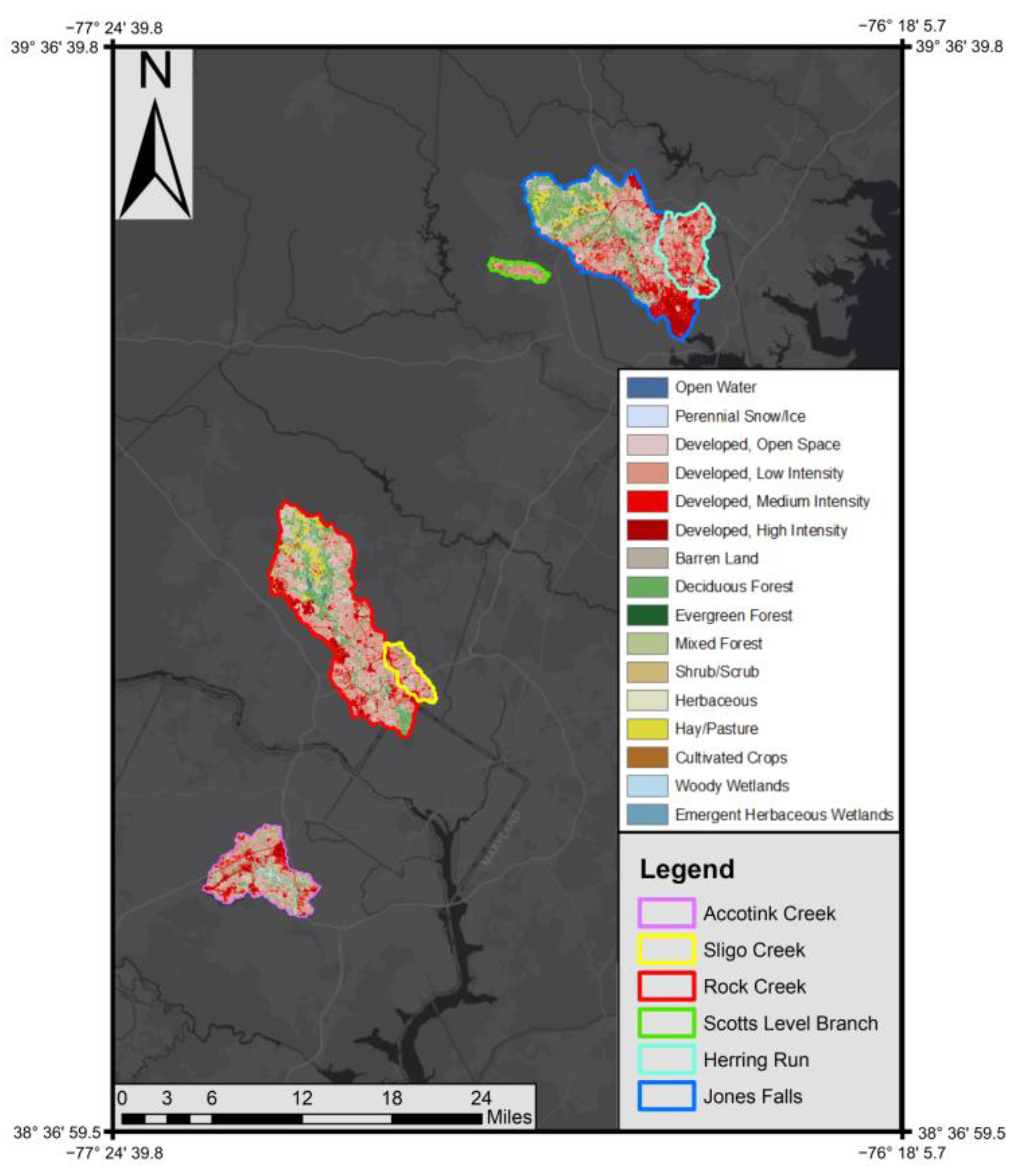
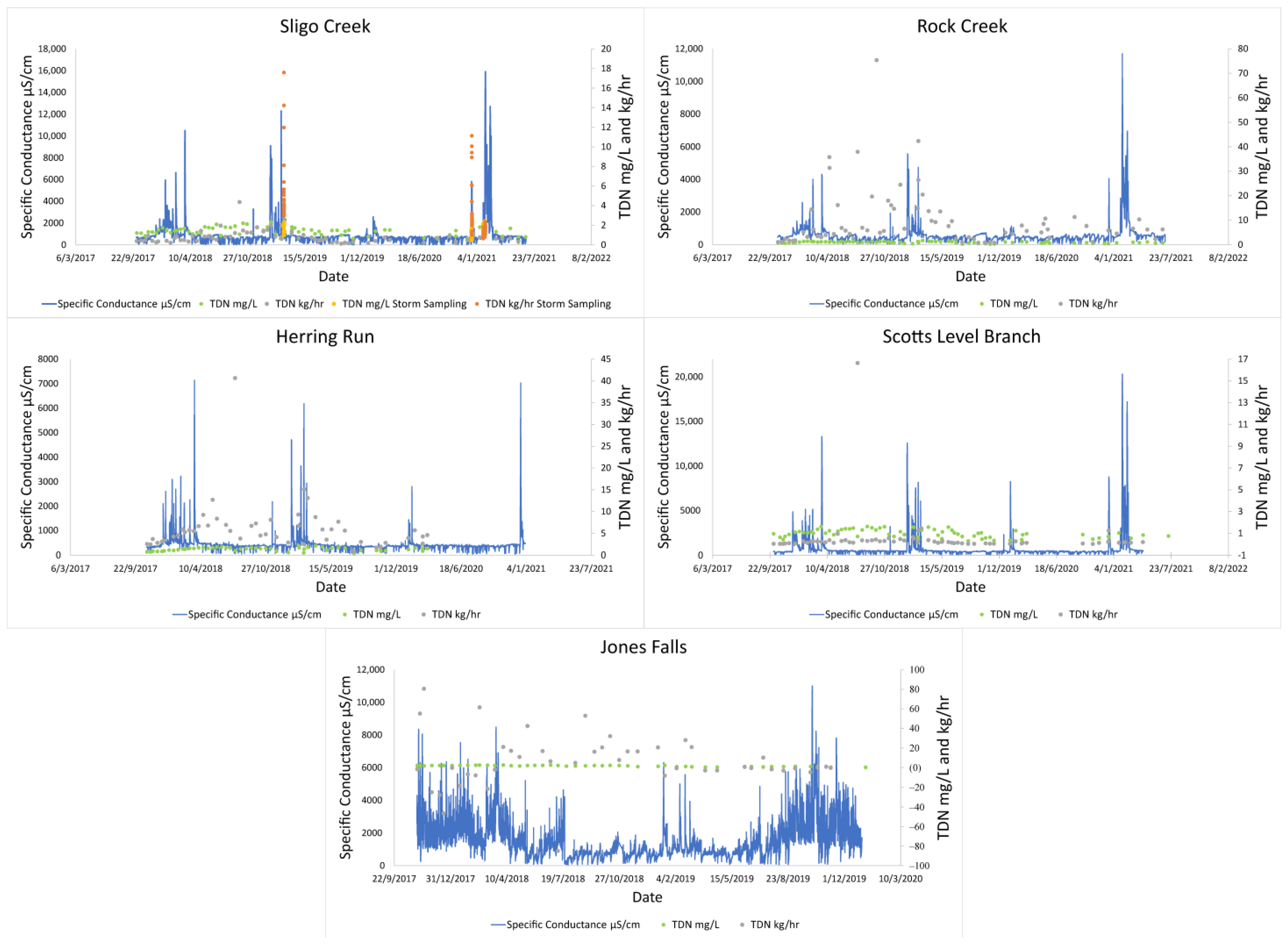

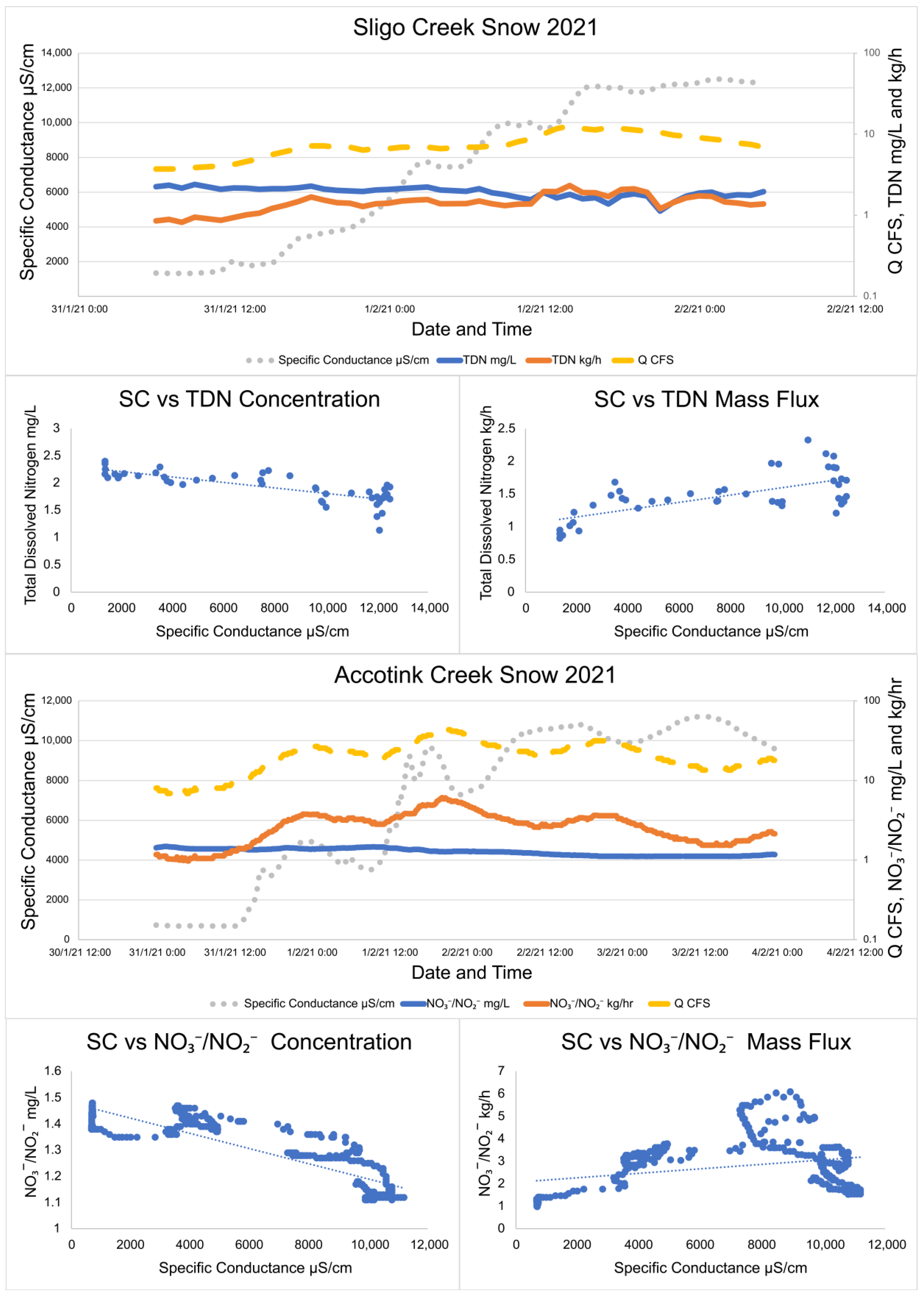
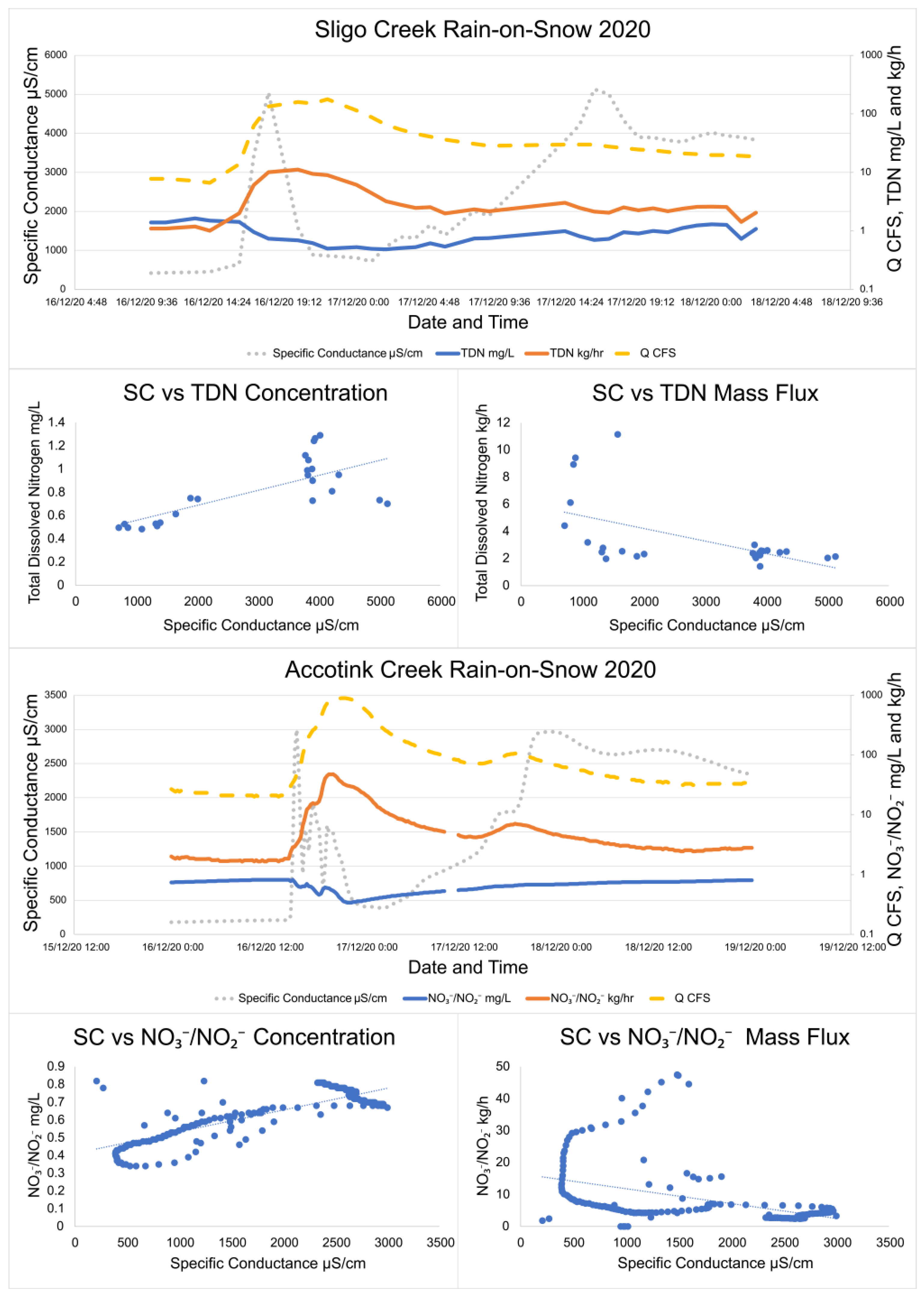
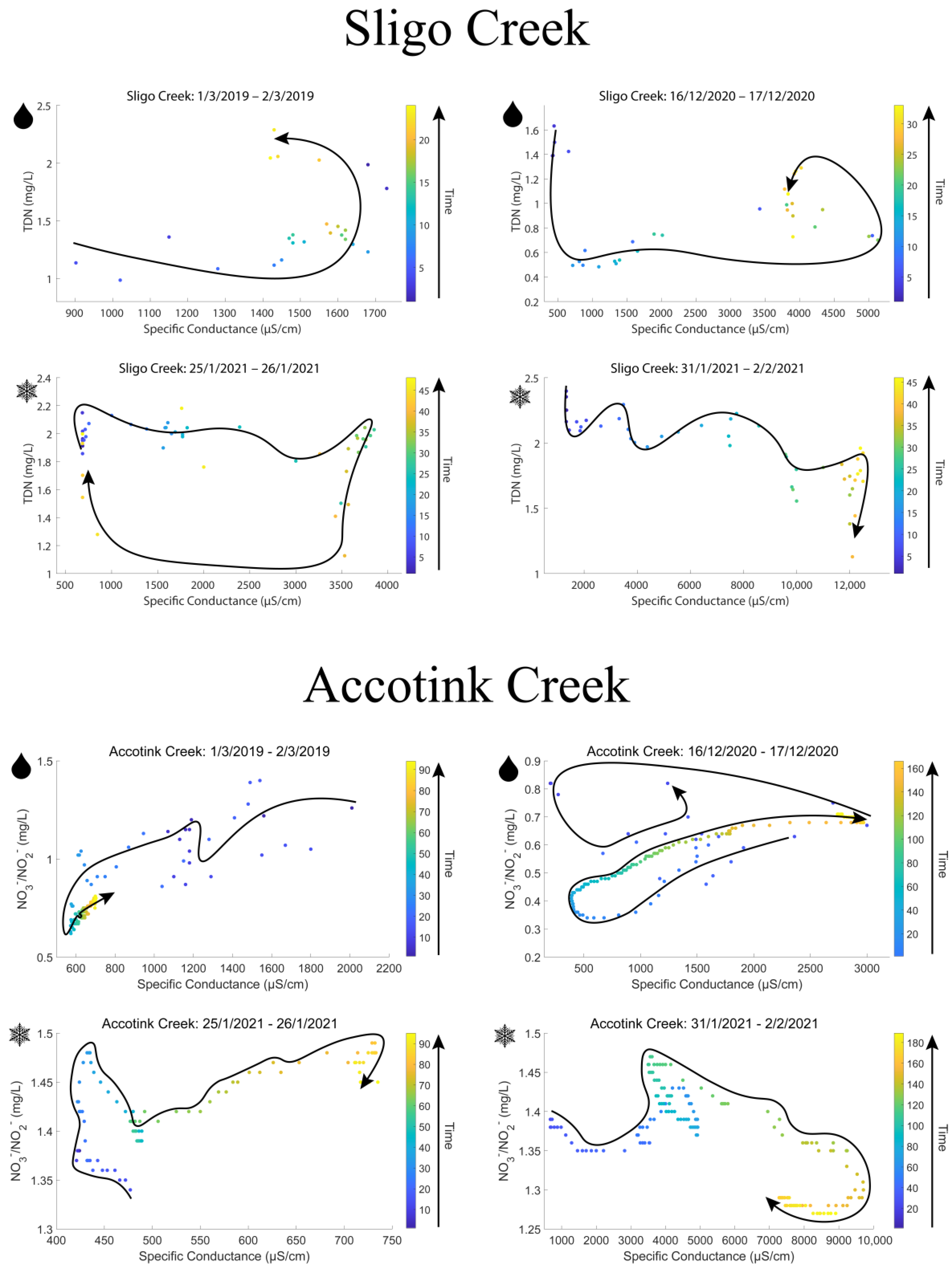
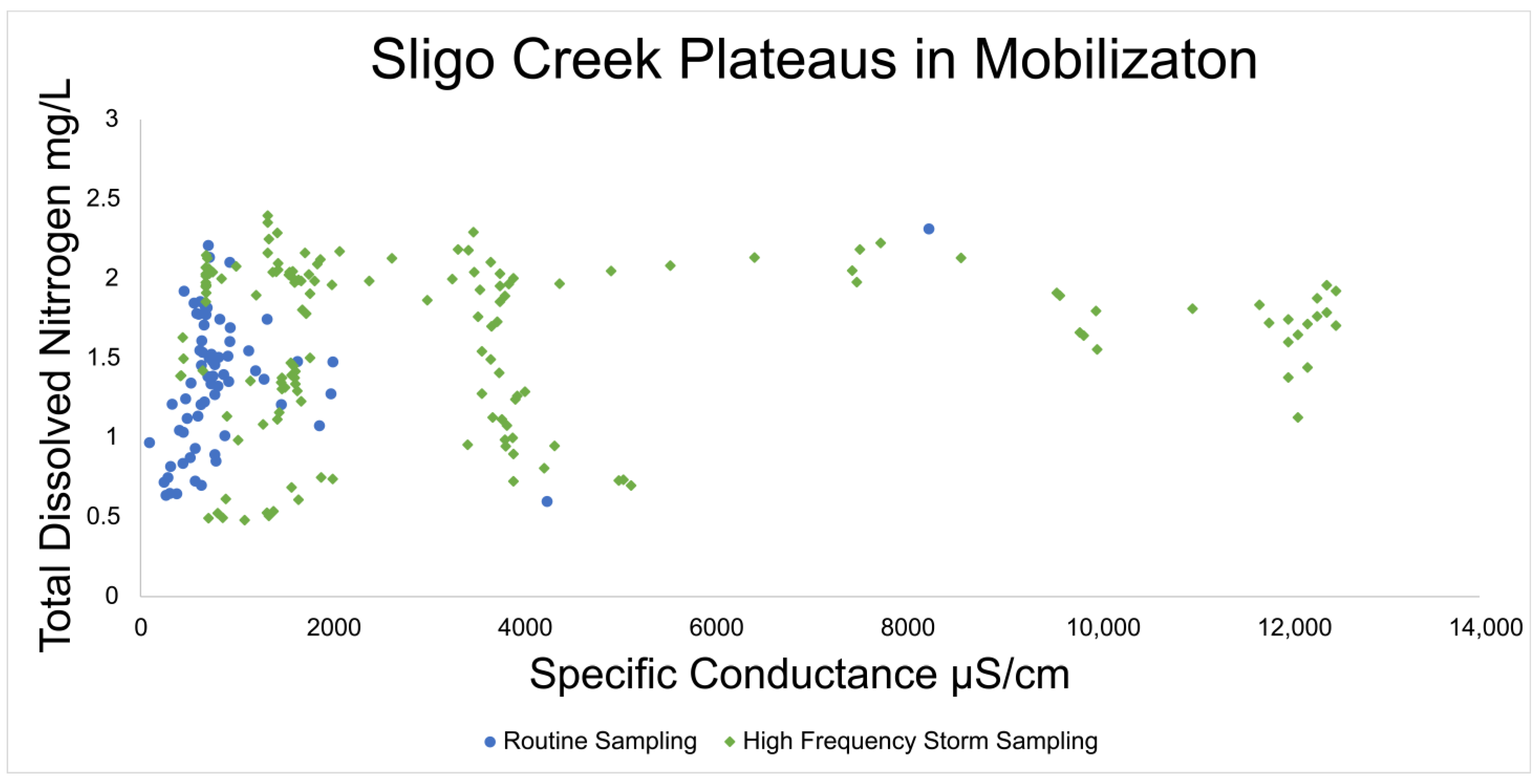
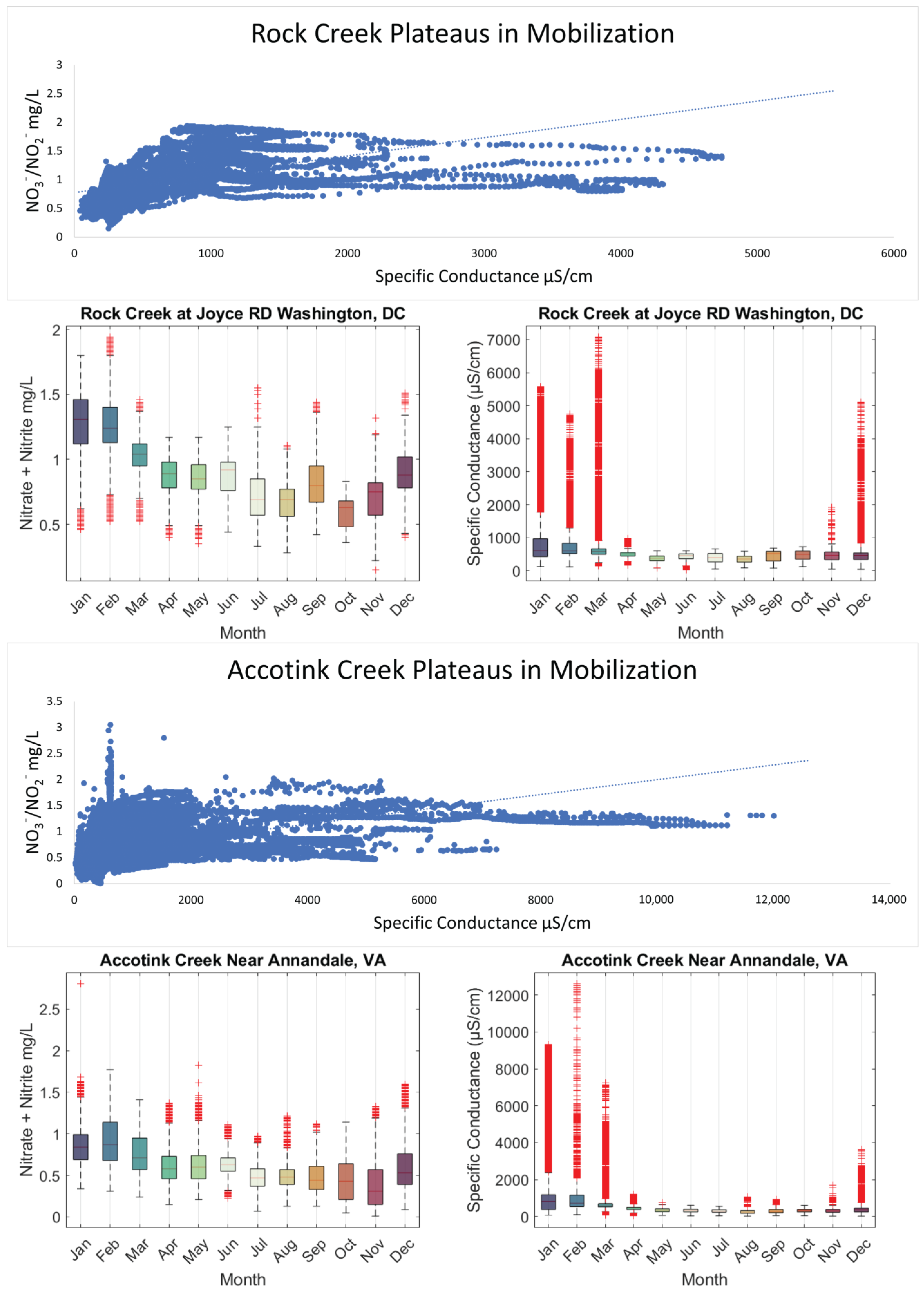
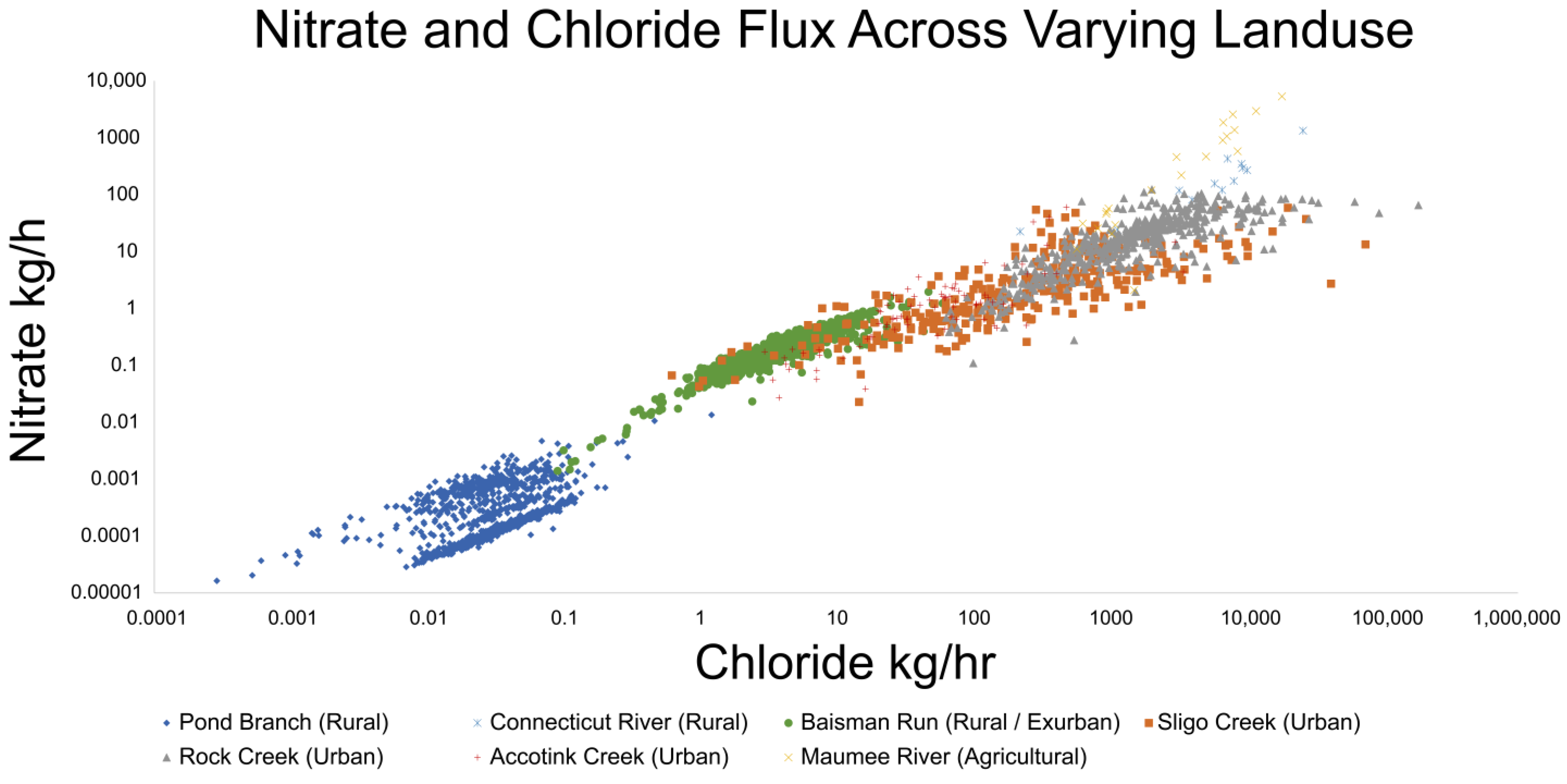

| Study Site | State/Metro Area | Latitude | Longitude | USGS Site Number | NLCD 2016 Impervious Surface Cover % | Monitoring Duration |
|---|---|---|---|---|---|---|
| Rock Creek | Washington DC | 38°57′36.6″ | 77°02′31.4″ | 1648010 | 18.35 | 19 October 2017–23 June 2021 |
| Sligo Creek | Washington DC | 38°59′10.4″ | 77°00′17.5″ | 1650800 | 27.19 | 4 October 2017–23 June 2021 |
| Scotts Level Branch | Baltimore MD | 39°21′41.7″ | 76°45′42.3″ | 1589290 | 22.24 | 4 October 2017–15 April 2021 |
| Herring Run | Baltimore MD | 39°19′04.7″ | 76°33′18.5″ | 1585219 | 32.76 | 26 October 2017–3 January 2019 |
| Jones Falls * | Baltimore MD | 39°17′02.8″ | 76°36′13.1″ | 1589485 | 21.28 | 1 November 2017–6 November 2019 |
| Accotink Creek | VA | 38°48′46” | 77°13′43” | 1654000 | 23.4 | 5 February 2015–1 Januray 2023 |
| Snow Event | Sampling Initiated | Sampling Ceased | N | Δ in Specific Conductance μS/cm |
|---|---|---|---|---|
| 1 | 1 March 2019, 20:23 | 2 March 2019, 19:23 | 24 | 902–1730 |
| 2 | 16 Decmeber 2020, 10:00 | 18 Decmeber 2020, 3:10 | 33 | 419–5130 |
| 3 | 25 January 2021, 17:30 | 26 January 2021, 17:00 | 48 | 682–3850 |
| 4 | 31 January 2021, 6:00 | 2 February 2021, 5:00 | 46 | 1330–12,500 |
Disclaimer/Publisher’s Note: The statements, opinions and data contained in all publications are solely those of the individual author(s) and contributor(s) and not of MDPI and/or the editor(s). MDPI and/or the editor(s) disclaim responsibility for any injury to people or property resulting from any ideas, methods, instructions or products referred to in the content. |
© 2023 by the authors. Licensee MDPI, Basel, Switzerland. This article is an open access article distributed under the terms and conditions of the Creative Commons Attribution (CC BY) license (https://creativecommons.org/licenses/by/4.0/).
Share and Cite
Galella, J.G.; Kaushal, S.S.; Mayer, P.M.; Maas, C.M.; Shatkay, R.R.; Inamdar, S.; Belt, K.T. Freshwater Salinization Syndrome Alters Nitrogen Transport in Urban Watersheds. Water 2023, 15, 3956. https://doi.org/10.3390/w15223956
Galella JG, Kaushal SS, Mayer PM, Maas CM, Shatkay RR, Inamdar S, Belt KT. Freshwater Salinization Syndrome Alters Nitrogen Transport in Urban Watersheds. Water. 2023; 15(22):3956. https://doi.org/10.3390/w15223956
Chicago/Turabian StyleGalella, Joseph G., Sujay S. Kaushal, Paul M. Mayer, Carly M. Maas, Ruth R. Shatkay, Shreeram Inamdar, and Kenneth T. Belt. 2023. "Freshwater Salinization Syndrome Alters Nitrogen Transport in Urban Watersheds" Water 15, no. 22: 3956. https://doi.org/10.3390/w15223956
APA StyleGalella, J. G., Kaushal, S. S., Mayer, P. M., Maas, C. M., Shatkay, R. R., Inamdar, S., & Belt, K. T. (2023). Freshwater Salinization Syndrome Alters Nitrogen Transport in Urban Watersheds. Water, 15(22), 3956. https://doi.org/10.3390/w15223956










